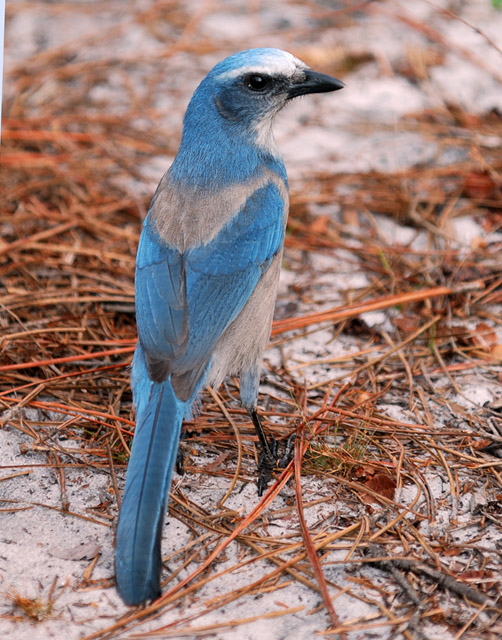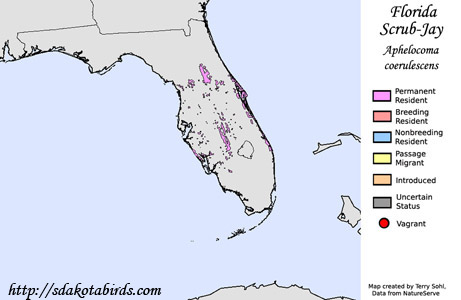| Length: 11 inches | Wingspan: 14 inches | Seasonality: Non-resident in South Dakota |
| ID Keys: Blue wings and tail, blue head with white on forehead and throat, gray on back, grayish underparts | ||
 The
Florida Scrub-Jay is aptly named, found nowhere else in the world other than
the state of Florida, and found in areas with short, scrubby oak trees. They
were once considered as part of one scrub-jay species, along with the
Western Scrub-Jay and
Island
Scrub-Jay of the western United States. Florida Scrub-Jays are
considered a "threatened" species in the United States. Their
preferred habitat is only found in scattered locations, and heavy
development of central and coastal Florida has resulted a significant loss
of habitat. Their preferred scrubby oak woodlands are also naturally
maintained by fire, but with heavy urban development in Florida, fire
suppression has altered the natural ecosystems, including the habitats that
Florida Scrub-Jays depend upon. In addition to habitat loss,
fragmentation of remaining habitat is an issue. Most Florida
Scrub-Jays are very sedentary, rarely leaving the general location where
they breed, and as habitat fragmentation continues to occur, remaining
populations become increasingly isolated from each other. Florida
Scrub-Jay populations have declined by over 90% over the last century.
The
Florida Scrub-Jay is aptly named, found nowhere else in the world other than
the state of Florida, and found in areas with short, scrubby oak trees. They
were once considered as part of one scrub-jay species, along with the
Western Scrub-Jay and
Island
Scrub-Jay of the western United States. Florida Scrub-Jays are
considered a "threatened" species in the United States. Their
preferred habitat is only found in scattered locations, and heavy
development of central and coastal Florida has resulted a significant loss
of habitat. Their preferred scrubby oak woodlands are also naturally
maintained by fire, but with heavy urban development in Florida, fire
suppression has altered the natural ecosystems, including the habitats that
Florida Scrub-Jays depend upon. In addition to habitat loss,
fragmentation of remaining habitat is an issue. Most Florida
Scrub-Jays are very sedentary, rarely leaving the general location where
they breed, and as habitat fragmentation continues to occur, remaining
populations become increasingly isolated from each other. Florida
Scrub-Jay populations have declined by over 90% over the last century.
Habitat: Found in natural, scrubby oak woodlands found in areas of sandy soil, preferring areas with oak tree heights of no more than 10 feet.
Diet: Omnivorous, but feeds heavily on insects, spiders, and other invertebrates during most months. They will also feed on fruits, berries, and seeds, and often depend heavily on acorns during the winter months, when other food items are not as available.
Behavior: Uses a variety of foraging techniques, depending upon food item and location. They will often stash large numbers of acorns in sandy soil areas for later use.
Nesting: Florida Scrub-Jays have a cooperative nesting behavior, where one adult breeding pair is assisted by multiple "helper" birds, with the helpers often previous offspring of the nesting pair. Nesting usually occurs in small scrub oak trees, between 3 and 10 feet from the ground. The female lays 3 or 4 eggs. The young leave the nest after 15 to 20 days, but typically remain close to the parents for many weeks after fledging.
Song: Has a variety of harsh calls, with clucking notes, harsh shrieking, and squawking.
Migration: Considered a permanent resident throughout its normal range.
Interactive eBird Map: Click here to access an interactive eBird map of Florida Scrub Jay sightings
Similar Species: In range, not likely to be confused with other species. They are similar in appearance to the Western Scrub-Jay and the Island Scrub-Jay, two species with ranges far from Florida.
Conservation Status: Populations have been in decline, and remaining habitat is degraded and fragmented. The IUCN lists the Florida Scrub-Jay as a "Vulnerable" species.
Further Information: 1) Audubon - Florida Scrub-Jay
2) BirdLife International - Florida Scrub-Jay
3) Field Guide to Rare Animals of Florida - Florida Scrub-Jay
Photo Information: Photo taken by VTHokiEE06 - November 20th, 2009 - Cruickshank Sanctuary, Brevard County, Florida - Photo licensed under Creative Commons Attribution NonCommercial NoDerivs 2.0 Generic License.
| Click below for a higher-resolution map |
 |
| South Dakota Status: Non-resident in South Dakota |
Additional Florida Scrub-Jay Photos (coming soon!!)
